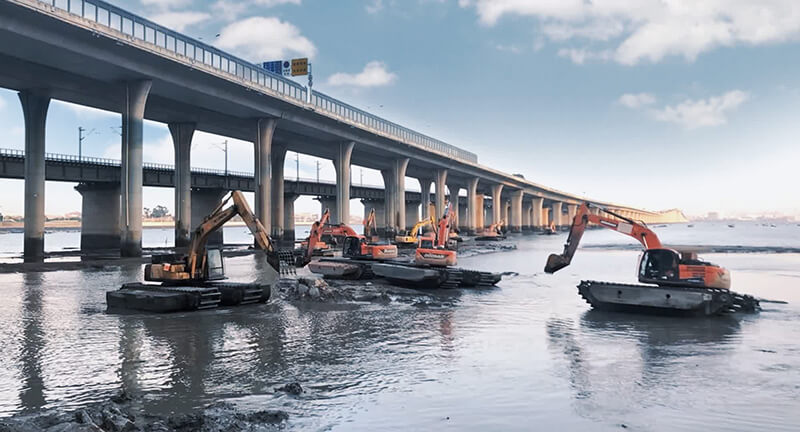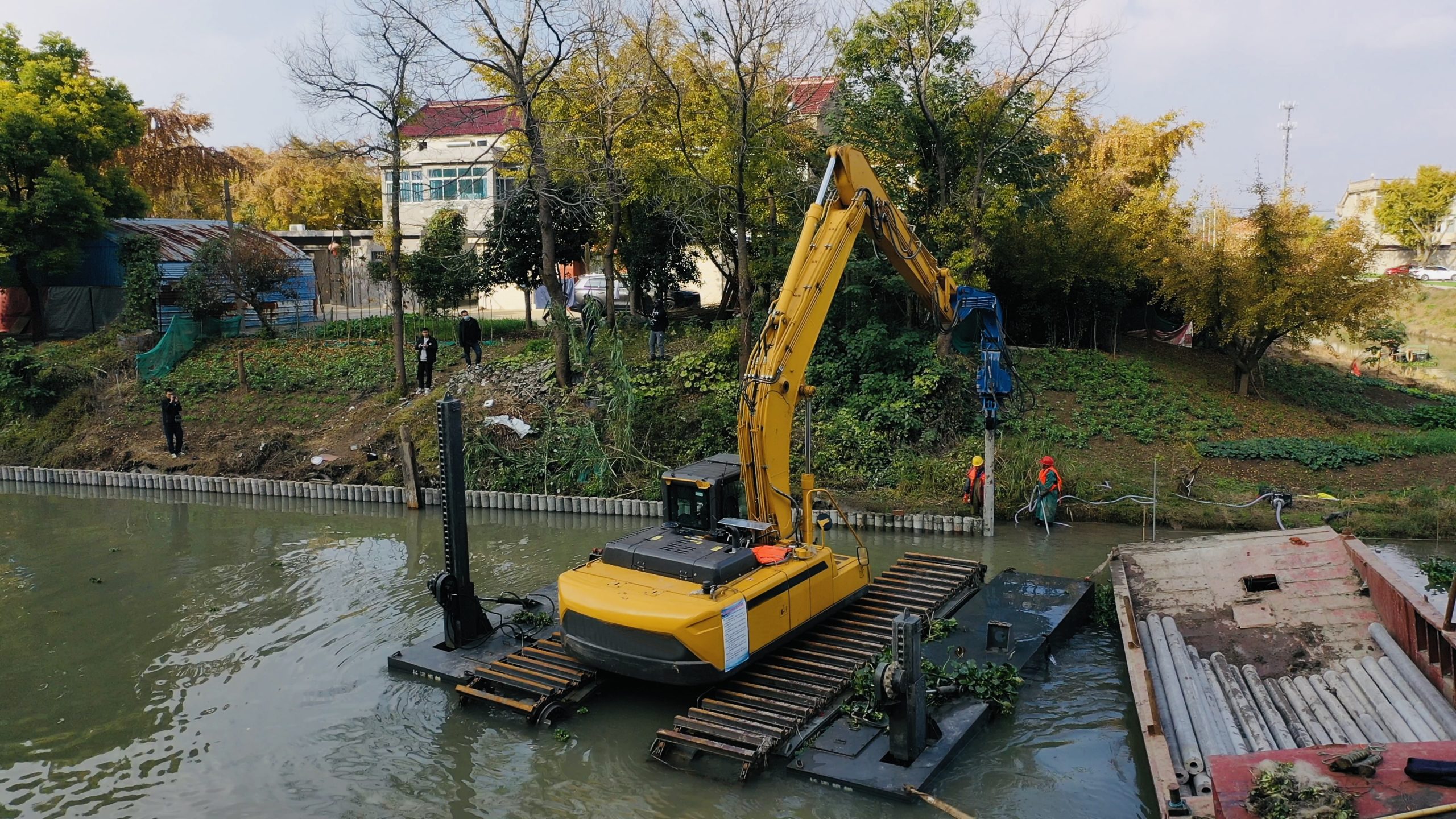Pontoon excavators, much like any heavy machinery, require adherence to strict safety protocols to ensure the safety of operators and bystanders. Among the primary safety measures are flotation devices and personal flotation devices (PFDs) for each crew member, which are essential in pontoon boat safety. This equipment helps prevent drowning incidents if an operator accidentally falls into the water.
Furthermore, these pieces of equipment should be equipped with a signaling device, such as distress lights or an approved throwable device, to quickly alert others in cases of emergency. Operators must be trained to use these devices effectively, from smoke signals in daylight to distress lights after dark, enhancing safety during operations.
What Are Pontoon Excavators?
Pontoon excavators, also called marine or amphibious excavators, are specialized machines tailored for excavation in aquatic environments such as rivers, lakes, ponds, swamps, or coastal areas. These excavators are distinctively designed with large pontoons or floating platforms, enabling them to operate in shallow water or even float on the water’s surface while carrying out tasks.
- The pontoons of these excavators provide buoyancy and stability, allowing them to access areas inaccessible to traditional land-based excavators.
- They are particularly useful in navigating marshes, wetlands, and other shallow water bodies where standard equipment would struggle to operate effectively.
- Pontoon excavators are equipped with various attachments for specific tasks, such as dredging buckets for removing sediment, hydraulic hammers for underwater rock breaking, or clamshell buckets for material handling.
- Their adaptability enables them to perform various functions, including dredging, vegetation clearance, bank reinforcement, and underwater construction.
These excavators are instrumental in environmental conservation and waterway maintenance efforts. They play a vital role in projects focused on wetland restoration, riverbank stabilization, and flood control measures due to their ability to operate in sensitive ecological areas without causing significant disruption.
Features of a Pontoon Excavator
Pontoon excavators come with an array of features tailored for aquatic environments. These include specialized materials for track shoes for traction on slippery surfaces, track chain rollers for smooth movement, and wear pads to resist underwater abrasive conditions. The design also incorporates screws for excavator components, robust hydraulic oil pipes, fittings to withstand the hydraulic pressure, and guide and drive wheels that undergo heat treatment for durability.
Specialized Track Shoes Material
The track shoes of pontoon excavators are made from specialized materials that provide enhanced grip and durability in aquatic conditions. These materials are selected to withstand the wear and tear of underwater use while maintaining the excavator’s stability on soft or uneven surfaces. This ensures safe and efficient operation, reducing the risk of slippage or sinking.
Track Chain Roller
Track chain rollers are a critical component of pontoon excavators, ensuring the continuous and smooth movement of the tracks. These rollers are designed to endure the unique stresses of operating in an aquatic environment, including resistance to rust and corrosion, which could otherwise compromise the excavator’s mobility and safety.
Wear-Pad for Resistance
Wear-pads are installed on pontoon excavators to counteract the abrasive underwater environment. These pads are made from materials that resist erosion and degradation, ensuring the pontoons’ longevity and the excavator’s stability. Regular inspection of wear pads is vital to equipment maintenance and operational safety.
Screws for Excavator
Screws for excavator components in a pontoon set-up are specifically designed to withstand the dynamic forces and corrosive elements encountered during water-based operations. Their robust construction ensures that the pontoon excavator remains securely assembled, reducing the risk of mechanical failure and enhancing overall safety.
Hydraulic Oil Pipes & Fittings
The hydraulic system of a pontoon excavator is a complex network of oil pipes and fittings. These components are engineered to handle the high-pressure demands of hydraulic operations while preventing leaks and failures. Regular inspections are crucial to detect any wear or damage which could lead to unsafe operating conditions.
Guide & Drive Wheel Heat Treatment
Guide and drive wheels on pontoon excavators undergo a heat treatment process to enhance their strength and resistance to wear. This treatment ensures that these critical components can endure the stress of excavation and movement, thereby reducing the risk of operational failures and maintaining a high level of safety.
How to Operate a Pontoon Excavator Safely?
Operating a pontoon excavator safely requires a firm understanding of the machine’s weight capacity and the unique considerations of amphibious excavators. Operators must be thoroughly trained to handle the complexities of maneuvering and excavating while afloat, ensuring the stability and safety of the operations at all times.
Familiarization of Controls
Before operating a pontoon excavator, operators must become familiar with the controls. Understanding the function of each lever and button is essential for safe operation. This knowledge allows operators to respond quickly and accurately to changing conditions, preventing accidents and ensuring efficient excavator use.
Perform Pre-Operational Checks
Pre-operational checks are critical to ensuring the safety of pontoon excavators. These checks include verifying the integrity of life jackets and other safety equipment, ensuring all mechanical systems function correctly, and confirming that the machine is in optimal condition for the day’s work.
Cabin Layout and Stability
The cabin layout of a pontoon excavator is designed to maximize operator comfort and control while maintaining the machine’s stability. Operators must be familiar with the cabin layout to ensure they can access all controls without compromising their safety or the excavator’s balance during operation.
Starting the Excavator
Starting a pontoon excavator requires a specific procedure to ensure the machine functions correctly. Operators must follow the manufacturer’s guidelines to activate the engine and hydraulic systems, checking for any signs of malfunction that could pose a safety risk during operation.
Controlling Excavator’s Movements
Controlling a pontoon excavator’s movements is a delicate task that requires precision and awareness of the machine’s capabilities. Operators must be adept at maneuvering the excavator, considering the aquatic environment to avoid accidents and ensure the safety of the operation.
Digging and Excavation
When operating a pontoon excavator, it’s crucial to monitor the weight capacity of the bucket to prevent tipping. Excavating within the machine’s operational limits ensures safety and efficiency. Operators should use smooth movements to dig and avoid abrupt actions that may unbalance the pontoon excavator. Additionally, always confirm the firmness of the underwater terrain to safeguard against sinking or destabilization during excavation.
Lifting and Moving
In lifting and moving materials, operators must adhere to the pontoon excavator’s specified weight capacity to maintain stability. Before lifting, ensure materials are securely fastened, and the lift path is clear. Smooth and controlled movements are essential to prevent the pontoons from shifting. Operators should also be vigilant of the excavator’s position relative to the water’s edge to prevent accidents.
Dumping and Loading
Dumping and loading operations should be conducted precisely, respecting the pontoon excavator’s balance and weight capacity. Operators need to position themselves for optimal reach and stability. The dumping area must be assessed for safety, ensuring that the load is released slowly to prevent sudden weight shifts that could destabilize the pontoon excavator.
Safety Protocols for Operating Pontoon Excavators
Operators should adhere to essential safety tips, including carrying an aid kit and basic tools and ensuring all safety gear meets USCG requirements. To meet boating safety standards, a pontoon excavator should have an orange distress flag and an air horn. Verify expiration dates on safety equipment and never exceed the number of passengers on board as per capacity limits.
Operator Training and Certification
Operators must comply with state laws concerning excavator safety. Training programs must certify operators handling pontoon excavators, focusing on machine-specific controls and safety protocols. This certification ensures operators know to maintain safety and respond to potential hazards on the job site.
Site Preparation and Assessment
A thorough site assessment is vital before operation. This includes evaluating underwater conditions, overhead obstacles, and proximities to water edges. Planning the excavation or construction project with these factors ensures a safe operating environment for the pontoon excavator and its operators.
Use of Personal Protective Equipment (PPE)
Operators must wear USCG-approved personal floatation devices and standard PPE to enhance safety. Helmets, safety glasses, and protective footwear are also essential to protect against potential hazards encountered during pontoon excavator operations.
Equipment Inspection and Maintenance
Regular inspection and maintenance are critical for ensuring the long-term safety and functionality of the pontoon excavator. This includes verifying the integrity of safety equipment, ensuring the boat is in motion with proper caution, and confirming that every person on board knows the location and use of fire extinguishers.
Maintaining a Safe Distance from Water Edges
Maintaining a safe distance from water edges is crucial to prevent the pontoon excavator from capsizing or becoming unstable. Operators should be aware of the water depth and current and avoid operating too close to the edge where the ground may be less stable.
Stability Management
Managing the stability of a pontoon excavator involves regular checks of the pontoons and adherence to weight limits during operation. Operators should adjust operations based on the load and distribution to maintain equilibrium and employ stabilizing techniques to prevent accidents.
Weather Monitoring
Operators must monitor weather conditions, as changes can impact safety and operations. A pontoon excavator’s powerful engine may cope with normal conditions, but high winds or severe weather can greatly affect stability and safe operation. It’s imperative to suspend operations if adverse weather threatens the site’s safety.
Communication and Signal Systems
Effective communication and signal systems are vital for coordinating the safe operations of a pontoon excavator. Operators should use clear signals to direct movements and ensure all team members are informed of ongoing activities. This reduces the risk of accidents and ensures smooth operation.
Emergency Procedures
Establishing procedures in the event of an emergency is essential. Operators must be trained to respond quickly and effectively, whether shutting down the pontoon excavator, evacuating personnel, or using emergency communication devices to seek assistance.
Wrap-Up!
Operating pontoon excavators requires adherence to stringent safety protocols to ensure operators’ well-being and the amphibious equipment’s efficiency. From understanding the intricate features of the machinery to implementing rigorous pre-operational checks, each step is crucial for maintaining safety standards. Operators must be versed in emergency procedures, including the strategic placement of ring buoys and the knowledge of engine cut-off procedures, to respond effectively in case of unforeseen incidents.


